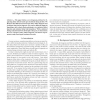15792 search results - page 24 / 3159 » Computational Abstraction Steps |
ICRA
2006
IEEE
14 years 1 months ago
2006
IEEE
— We propose a method of maintaining balance for a human-like character against large perturbations. The method enables a human-like model to maintain its balance with active who...
ECAL
2003
Springer
14 years 1 months ago
2003
Springer
Abstract. Path integration is a widely used method of navigation in nature whereby an animal continuously tracks its location by integrating its motion over the course of a journey...
FMSD
2000
13 years 7 months ago
2000
We review a number of formal verification techniques supported by STeP, the Stanford Temporal Prover, describing how the tool can be used to verify properties of several versions o...
DATE
2003
IEEE
14 years 1 months ago
2003
IEEE
Abstract — This paper defines a new diagnosis problem for diagnosing delay defects based upon statistical timing models. We illustrate the differences between the delay defect d...
EPIA
2001
Springer
14 years 9 days ago
2001
Springer
Abstract. The situation calculus, originally conceived by John McCarthy, is one of the main representation languages in artificial intelligence. The original papers introducing th...

